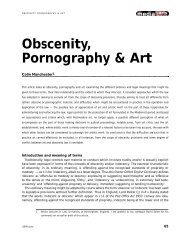Recent controversy over Phillip Gwynne's book Deadly, Unna? and ...
Recent controversy over Phillip Gwynne's book Deadly, Unna? and ...
Recent controversy over Phillip Gwynne's book Deadly, Unna? and ...
Create successful ePaper yourself
Turn your PDF publications into a flip-book with our unique Google optimized e-Paper software.
Gray, ‘Imagination, Fraud <strong>and</strong> the Cultural Protocols Debate’<br />
the National Association for the Visual Arts, <strong>and</strong> are available on the NAVA<br />
website. 5 Griffith University’s Key Centre for Cultural <strong>and</strong> Media Policy (‘CMP’) has<br />
produced videos dealing with legal <strong>and</strong> cultural protocols in the indigenous arts <strong>and</strong><br />
cultural industry. 6<br />
What do cultural protocols require of creators, particularly non-indigenous creators,<br />
who wish to deal with indigenous material? Do they set out minimum st<strong>and</strong>ards, with<br />
prescriptive force, or do they merely describe st<strong>and</strong>ards of behaviour to which<br />
creators should, in an ideal world, aspire? Are they legal in nature or merely ethical?<br />
What, if anything, are the penalties for breach?<br />
From a lawyer’s perspective at least, the answers to these questions are not always<br />
clear. Arguably, cultural protocols are primarily ethical in nature. They describe levels<br />
of behaviour which indigenous people <strong>and</strong> communities expect of outsiders dealing<br />
with indigenous material. In one sense, therefore, as the author of the SBS Shorter<br />
Protocols Guide has commented, ‘they are about underst<strong>and</strong>ing, not control.’ 7<br />
At the same time there is a strong element of the prescriptive in cultural protocols.<br />
They are expressed in m<strong>and</strong>atory language. They appear to reflect the requirements of<br />
indigenous laws <strong>and</strong> customs, even where such laws <strong>and</strong> customs are not recognised<br />
by the Australian legal system. Hence, they occupy an uneasy terrain. Regarded as<br />
law by many indigenous people, they are viewed with suspicion by some creators who<br />
(as we shall see later) consider them attempts to smuggle into the cultural pantheon an<br />
impostor whose true name is censorship, masquerading as law.<br />
The protocols are not always entirely clear on such issues as who must be consulted,<br />
<strong>and</strong> whether consultation includes a right of veto or control <strong>over</strong> content. Under the<br />
SBS Shorter Protocols Guide, for example, filmmakers dealing with Aboriginal<br />
communities are required to seek permission to travel <strong>and</strong> film on Aboriginal l<strong>and</strong>.<br />
Filmmakers must discuss with the ‘subject’ (presumably, this includes all Aboriginal<br />
5 See Doreen Mellor <strong>and</strong> Terri Janke, Valuing Art, Respecting Culture: Protocols for working with the<br />
Australian Indigenous visual arts <strong>and</strong> craft sector (2001), available at www.visualarts.net.au.<br />
6 See http://www.transworldeducation.com/articles/media.htm.



![ERIN O'DWYER [92] Introduction Striking a balance between ...](https://img.yumpu.com/14667367/1/184x260/erin-odwyer-92-introduction-striking-a-balance-between-.jpg?quality=85)


